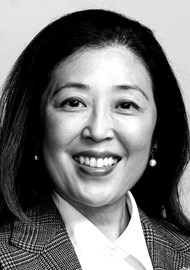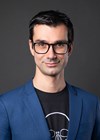We were lucky to sit down with Ioannis Goutos and Vania Hiratsuka recently and hear about QMUL’s MSc in Aesthetic Medicine which is designed for both new students and established clinicians.

Ioannis Goutos.

Vania Hiratsuka.
Thank you both for taking the time to speak with us today. Could you first introduce yourselves?
Ioannis Goutos (IG): My name is Ioannis Goutos. I am a Consultant Plastic Surgeon as well as the Director of the Academic Plastic Surgery programmes at Queen Mary University of London (QMUL). The Aesthetic Medicine programme has been the focus of the suite over the last five years.
Vania Hiratsuka Dalmedo (VHD): My name is Vania Hiratsuka Dalmedo. I’m a dentist qualified in Brazil and I've been working in the UK for the past 25 years and practising aesthetic medicine, alongside dentistry, since 2007. My interest in aesthetic medicine started when I completed a certificate for facial aesthetics masterclass by the Royal College of Surgeons of England. This was followed by a master’s degree in aesthetic medicine at QMUL, where I now have a role as Clinical Senior Lecturer, while also being the Lead for Clinical Activities and External Engagement. Simply put, I organise and oversee the delivery of any on-site clinical activity and simulation training associated with the aesthetics programme, also engaging with external speakers for collaboration.
Can you tell us a little bit about how the MSc in Aesthetic Medicine course came to be?
IG: It is quite clear that there has been quite a rapid expansion when it comes to aesthetic medicine provision worldwide. Nevertheless, the credentialisation of this emerging subspecialty falls behind significantly, and despite a number of different initiatives by training bodies, as well as royal colleges, we are still lacking a defined regulatory framework.
Within the QMUL course, we present one of the most long-standing initiatives to try and provide a degree of credentialisation for aesthetic medicine practitioners, especially when it comes to the educational element. The aesthetic medicine programmes at QMUL have really paved a new way in this attempt to regulate aesthetic medicine.
VHD: Agreed, and I think this course feeds into that. This is a part-time course, so it allows for students to have other commitments anywhere in the world. We initially formulated the course for individuals who are already practising some aspects of aesthetic medicine – it will focus on complementing the practical skills, because there are many areas of knowledge commonly missing.
I think the most important aspect here, as Ioannis mentioned, is regulations. We also needed to make sure that clinicians can develop their self-appraisal skills with this course. For the beginners and all those who have never practised aesthetic medicine, this provides them with the theoretical understanding of the procedures and allows these students to build a level of autonomy in terms of planning, managing the patients and other issues in aesthetic medicine.
All in all, it’s for both cohorts. And one thing that we have to remember is that this course is not just an academic course with theoretical knowledge or information about aesthetic medicine procedures – I think it goes beyond that because it provides our students with the knowhow to become more proficient in terms of communication and risk assessment, etc. All these aspects are very important in our day-to-day roles as aesthetic clinicians.
As the course is clearly designed to accommodate both students and professionals alike, how is it delivered so that it can provide as much learning as possible to both?
IG: Speaking a little about the structure of the course, it is divided into academic years and semesters. Students can choose between three different subtypes of qualification. The first one is the PG Certificate, which spans over one academic year and it covers four modules. The second option is the PG Diploma, which covers an extra four modules in the following academic year – so overall, eight modules, and students can also opt to study for the master’s degree, which is effectively the PG Diploma plus a dissertation.
These are the three different types of pathways within the QMUL Aesthetic Medicine qualification. Clearly, a number of our students will choose to study for the one-year postgraduate certificate and then upgrade into the postgraduate diploma or the MSc at a later stage. There is a degree of flexibility, furthermore, it needs to be emphasised that from this year we also have a January intake, so this provides an extra layer of flexibility for students to join in after the enrolment that most universities adhere to.
VHD: QMUL is part of the prestigious Russell Group, a body of leading UK universities dedicated to research and teaching experience. Providing this course, we have six faculty members, a mixture of doctors, dentists and nurses. We are very honoured to have Professor Sebastian Cotofana as a Visiting Professor, who I think everybody knows is a well-respected anatomist and he brings a wealth of knowledge and expertise to our faculty.
The module content is online, so students have access anytime; we also deliver weekly webinars and Prof Cotofana has some interactive sessions where we discuss and debate the main topics surrounding patient assessment, ageing, anatomy and injectables. We also provide simulation training, which is a face-to-face annual event. We always encourage the students to attend because that's where you have the practical learning element and it's really the stepping stone for them to choose their preferred area of focus as it covers all areas of aesthetics.
The students also benefit from the online forum where they can communicate with peers, because they are all mostly international students and are spread all over the world, so they can get to know each other and exchange information – it’s not just about the course but about experiencing aesthetic medicine.
In what ways do you feel as though the teaching can benefit a clinician’s position in the future?
IG: Given the fact that there is no defined regulatory element in aesthetic medicine, we believe that the university level 7 qualification is going to give students a very competitive advantage in the future, for when there will be a formal accreditation framework. VHD: I think aesthetic medicine became a little bit diluted over the years because there's such diversity in terms of who is doing aesthetics, so this would definitely differentiate those medical professionals with the level 7 accreditation.
And what about the potential future developments in research and academic aesthetics?
VHD: Well, because of the range of topics in aesthetic medicine, one should think that it's not just related to the clinical procedures – we are expanding into psychology, sociology and other areas where I think one could perhaps focus, in terms of research and academic practice; not just the clinical work that we do day-to-day. In the past few years, we have added an extra module that prepares students for the main principles of setting up practice in the field.
Finally, in terms of being reactive to new technologies and therapies, we endeavour to regularly bring in external speakers because they provide a wealth of knowledge and expertise in the areas they are practising in and provide our students with that ‘special touch’ of emerging trends in aesthetic medicine. Thank you so much for your time and for sharing with us these insights.
Declaration of competing interests: Both interviewees are employees of Queen Mary University of London.











